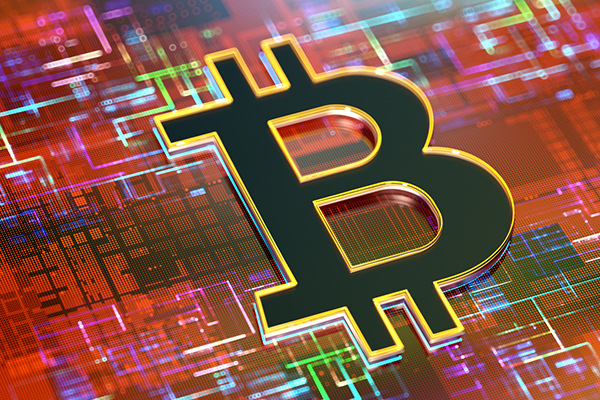Bitcoin, cryptocurrencies and blockchain – how it all works
There is growing interest in digital currencies among governments, financial institutions and individuals, but it can be a difficult world to understand. Gary McFarlane explains the history of bitcoin, how cryptocurrencies work and how to use them.
28th January 2025 12:09
by Gary McFarlane from interactive investor

Money is both physical and abstract. Historically we’ve exchanged physical notes or coins, but in recent years we’ve become more used to digital transactions on the internet and contactless payments in shops. Our money is now mostly held within online digital wrappers, accessed via internet accounts and banking apps.
In the past, societies used shells, metals such as gold, tally sticks, and paper as money, but we had to attach the abstract notion of trust to them. To understand how bitcoin is money, in the broad sense of being a way of transferring value, we need to start from those fundamentals. This allows us to work backwards from the breakdown of trust during the Great Financial Crisis (2007-08) to see how bitcoin and other cryptocurrencies came into being.
- Invest with ii: SIPP Account | Stocks & Shares ISA | See all Investment Accounts
How it all began
On 31 October 2008, a person or group named Satoshi Nakamoto published the bitcoin white paper, detailing how to create an electronic cash system.
A couple of months later, on 3 January 2009, bitcoin, which takes the form of a small computer file, was launched. Critics say it’s a solution without a problem, while believers contend that it solves the problem of central banks and governments inflating away the value of our money by influencing interest rates or printing money.
Bitcoin’s inventors made their intention explicit. A headline from The Times was included as a textual note in the first batch of transaction records (the so-called genesis block) on its ledger (a log that records transactions): “The Times 03/Jan/2009 Chancellor on brink of second bailout for banks.”
From metal coins to crypto – buying pizza with bitcoin
Nowadays, fewer people carry notes and coins, and we increasingly use digital forms of cash. So, how does digital cash that we access and spend via our laptops and smartphones differ from bitcoin and thousands of cryptocurrencies that have followed?
As distinct from our current legal tender, the bitcoin white paper introduced the concept of digitally based peer-to-peer (person-to-person) transactions, eliminating the need for intermediaries such as banks or governments.
Physical cash transactions are a type of peer-to-peer exchange (cash is a “bearer instrument”, which simply means whoever has physical possession of it is the owner of the value it represents), but replicating that online was difficult, until bitcoin came along.
- Digital assets: make cryptocurrencies great again
- Sign up to our free newsletter for investment ideas, latest news and award-winning analysis
However, it is one thing to write software and claim it as money, but quite another for it to be accepted by society. Using price discovery (how buyers and sellers establish the right price for something) as a measure for early adoption success, we can see how bitcoin gained a foothold.
On 17 March 2010, the first bitcoin exchange (bitcoinmarket.com) listed bitcoin (BTC) at just 0.3 US cents.
It was 17 months after its launch before bitcoin was used to buy any physical goods. Famously, computer programmer Laszlo Hanyecz used 10,000 BTC to buy two Papa Johns pizzas from Jeremy Sturdivant via an online bitcoin forum.
At the time, Hanyecz noted the favourable exchange rate for the pizza seller, known on the forum as Jercos. In May 2010, one bitcoin was worth just 10 US cents, and two pizzas could be bought for roughly $25-30, so the seller was receiving 10,000 BTC worth $100. When bitcoin hit $100,000 in December 2024, those 10,000 BTC would have been valued at $1 billion (over £800 million).
To pay the vendor, Hanyecz only needed the bitcoin “address” of the vendor – an alphanumeric string of between 26 and 35 characters.
Bitcoin transactions are verified by software, and the supply of bitcoin is capped at 21 million, determined by computer code. There are currently 19.81 million bitcoin in circulation. This limit means the currency cannot be debased, whereas governments can always print more paper money.
How bitcoin works (the technical bit)
Here’s how bitcoin transaction verification works. Bitcoin uses what’s called public-key cryptography for signing transactions and securing wallets. These wallets, which are used to store as well as send and receive cryptocurrency, can be thought of as a digital version of a normal physical wallet you might have in your pocket.
A private key unlocks the cypher (access to the wallet address), and together with the public key enables the sending and receiving of bitcoin. Public keys are often referred to as addresses. They are unique strings of letters and numbers that can be thought of as a digital mailbox. Remember, to buy that 10,000 BTC pizza, Hanyecz was interacting with bitcoin addresses.
To access the bitcoin at the receiving addresses, the private key is required. Losing the key means losing the bitcoin. This happened in 2013 to a man whose private key for 8,000 BTC, stored on his laptop hard drive, is currently somewhere in a landfill in Newport, Wales. It’s estimated that an incredible three million BTC has been lost from the theoretical current circulating supply of 19.81 million.

An aerial view of a Newport Council landfill site in 2022 in Newport, Wales. Source: Matthew Horwood/Getty Images.
At the heart of bitcoin security is a process called “hashing”, which is a way of encoding digital files into alphanumeric strings. It hashes blocks of transactions and uses this hash in the header information of the next block, creating a linked chain of blocks, or “blockchain”. Once the chain is formed and recorded, it cannot be changed, hence the concept of blockchain immutability. This makes transactions secure and transparent.
To find the correct hash (the correct key to unlock/reverse the encoding described above) computers running the open-source bitcoin code (a software application that anyone can download and use) take part in a brute-force competition – the more powerful the computer, the better the chance of winning. Each computer is a constituent part of the bitcoin network, and the first to find the hash wins. The proof-of-work must be confirmed by other computers on the bitcoin network before the new block is added. Each computer taking part in maintaining the bitcoin ledger – i.e. running the software – is known as a node.
- Funds and trusts four pros are buying and selling: Q1 2025
- 10 hottest ISA shares, funds and trusts: week ended 24 January 2025
Bitcoin mining, the process of producing new blocks, attracts a reward for winning the hashing competition. The block reward, initially 50 BTC per block, halves roughly every four years to reduce the rate of bitcoin supply. The fourth “halving”, in April 2024, reduced the reward to 3.125 BTC per block. The four-yearly halving event cycles significantly impact the price of bitcoin.
The bitcoin code outputs one block every 10 minutes. As computing power increases, the “difficulty” of finding the hash is adjusted automatically by the code to maintain this rate.
Given its “mining” design, it is reasonable to assume that Satoshi Nakamoto was a fan of gold.While many have dismissed the notion of bitcoin as digital gold, when chair of the the US central bank Jerome Powell says, “It’s like gold – it’s just virtual and digital”, it is worth paying attention.
The return of hard money? Don’t trust governments, trust the code
Bitcoiners advocate for “hard money” – what they see as a return to the principles of metal-based commodity money that underpinned the gold standard, where the value of a country's currency was directly linked to gold. They’d prefer to trust in a hard-coded fixed currency supply to preserve purchasing power rather than paper money.
While some find the reasoning compelling, they probably don’t expect bitcoin to completely replace government-issued currency such as dollars or sterling, or encourage billions of people without a bank account to suddenly start using bitcoin as a more accessible alternative.
Gold’s physical properties made it a suitable commodity for money. The effort to mine gold, plus its rarity, can provide a determination of value.
Bitcoin faces a more complex debate, especially when set alongside gold as the pre-eminent store of value established over thousands of years.
Nevertheless, the bitcoin network has never been hacked (although cryptocurrency exchanges and platforms have), is more divisible than gold (bitcoin can be divided and traded in fractions), is more portable and cheaper to hold in custody (a financial institution responsible for holding assets on a customer’s behalf).
Beyond bitcoin – what are cryptocurrencies?
Cryptocurrency is a confusing term. Most aren’t designed as currencies, and they don’t require excessive computing power to digitally mint new coins. Non-bitcoin crypto assets are often referred to as “altcoins” - alternatives to bitcoin.
Most cryptocurrencies are best understood as tokens that access services – anything from logistics and mortgage conveyancing to data storage and social media – hosted on a decentralised network (information processing distributed across multiple computing devices with no centralised controlling entity).
Many have their supply already created, while others use a “proof-of-stake” system, where block verifiers must hold a certain amount of coins to be eligible to contribute to securing the network. Ethereum (ETH), the second-largest crypto, has moved to this system and pays a reward to its block validators in the form of newly minted ETH coins.

Crypto is high risk
How far has crypto advanced in disrupting traditional finance (TradFi) or challenging the current monetary system?
Central banks and key players in sectors such as social media, ride-hailing, data storage, supply chain logistics, financial operations and trading are all yet to be disrupted by the promise of blockchain technology.
But despite claims to the contrary, crypto has made some, admittedly limited, progress in everyday money transactions. You can buy stuff with bitcoin and other crypto, from holidays and flights via Travala (monthly average users in December 2024 was almost 200,000), to pretty much anything else by using e-commerce companies such as Bitpay.com (although not available in the UK) and Coinage.com and, indirectly, via gift cards.
The industry where crypto has arguably gained most traction is betting and prediction markets. Polymarket was a breakout star of the US presidential election, attracting billions of dollars to its offshore gambling platform.
In other industries, the story is patchy, and the lack of regulatory clarity hasn’t helped. But that outlook could change if the Trump administration is as pro-crypto as promised.
Managing crypto risk
Investing in crypto is like investing in an early-stage company with unproven technology and lacking the projected mass adoption.
As such, crypto is high risk and should sit in the alternative asset bucket of an investment portfolio. Experts typically take this to mean no more than 2-3% of its total value. BlackRock suggests a 1-2% bitcoin allocation for a traditional 60/40 (shares/bonds) portfolio.
- Have fund managers changed their tune on crypto?
- Where to invest in Q1 2025? Four experts have their say
Crypto investment options, from higher to relatively lower risk, might include direct crypto investments, although bear in mind the custody and security issues. Then there are companies listed on the US and UK stock exchanges involved in the crypto industry, like crypto exchanges, bitcoin miners and buyers of bitcoin and altcoins. There are also blockchain-focused exchange-traded funds, or ETFs.
Alternatively, investors might prefer companies with some crypto exposure (or that might have in the future), but whose core business is elsewhere.
Disclaimer: the author has a holding in bitcoin and a range of other cryptocurrencies. He has no direct exposure to any of the stocks mentioned.
These articles are provided for information purposes only. Occasionally, an opinion about whether to buy or sell a specific investment may be provided by third parties. The content is not intended to be a personal recommendation to buy or sell any financial instrument or product, or to adopt any investment strategy as it is not provided based on an assessment of your investing knowledge and experience, your financial situation or your investment objectives. The value of your investments, and the income derived from them, may go down as well as up. You may not get back all the money that you invest. The investments referred to in this article may not be suitable for all investors, and if in doubt, an investor should seek advice from a qualified investment adviser.
Full performance can be found on the company or index summary page on the interactive investor website. Simply click on the company's or index name highlighted in the article.